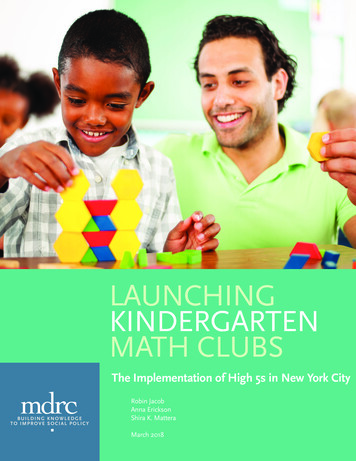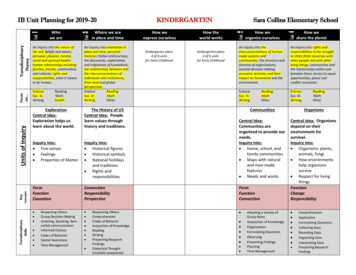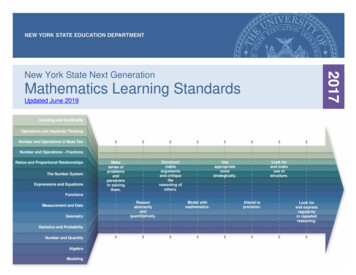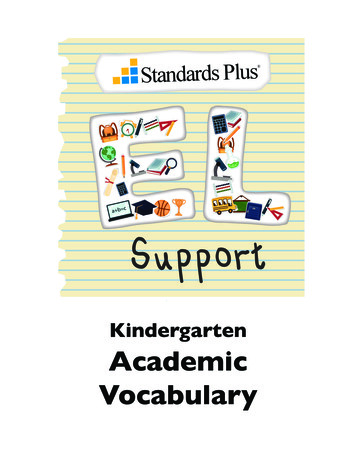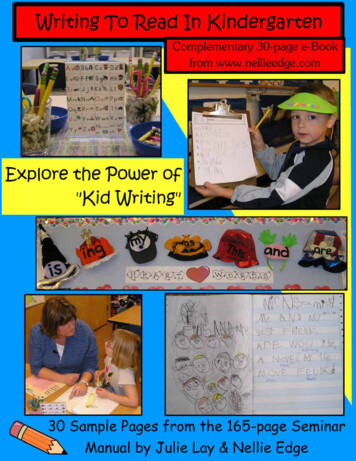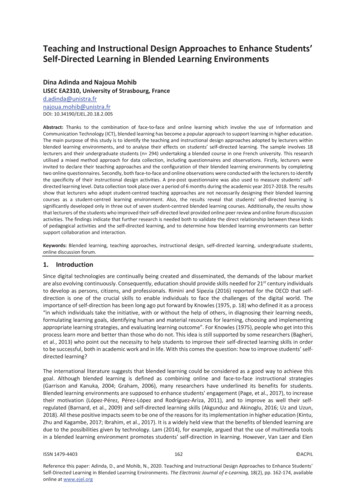
Transcription
APPROACHESTO LEARNINGKindergarten to Grade 3 GuideMarilou Hyson, Ph.D.Consultant, New Jersey Department of Education
Approaches to Learning, Kindergarten to Grade 3 GuideTABLE OF CONTENTSIntroduction .EPPIC Skills: Core Expectations for Approaches to Learning,Kindergarten to Grade 3 .1What Are “Approaches to Learning”?.3Approaches to Learning, Cognitive Development,Social-Emotional Development, and “SEL” .5Why Are Approaches-to-Learning Competencies So Important for Children in K-3?.6How Do Teachers Support the Growth of EPPIC Skills?.71Approaches to Learning Components, Child Behaviors, and Teacher SupportsComponent 1: Engagement . 10Component 2: Planning and Problem-Solving. 14Component 3: Initiative and Creativity. 17Summary and Final Thoughts. 20Addressing Yes-But Concerns . 21References and Resources . 26Appendix AAn Annotated Example: Opportunities for EPPIC Skill DevelopmentWithin a K-3 Curriculum Unit . 29Appendix BPromoting EPPIC Skills with Remodeled Lessons . 31Appendix CIncluding Approaches to Learning in K-3 PlanningTools to Adapt and Use. 34
Approaches to Learning, Kindergarten to Grade 3 GuideINTRODUCTIONAs a teacher in kindergarten and the primary grades, you know that children’s progress dependsgreatly on their motivation, interest, persistence, and ability to plan their work and manage theiremotions. Just as New Jersey educators are guided by standards in areas like literacy and mathematics,expectations are needed for the critically important domain of Approaches to Learning. This Guidedescribes each of the core expectations and indicators; defines Approaches to Learning and explains howthese competencies connect with other aspects of development; describes why Approaches to Learningcompetencies are so important for K-3 children; gives you grade-by-grade examples of how childrendemonstrate these competencies; and lists many examples of ways that you can support children’s EPPICskills: engagement in learning, their planning and problem-solving, and their initiative and creativity.Implementing Approaches to Learning for K-3 Students:What’s Here to Help YouThis Guide has many features intended to help K-3 teachers provide children with what theyneed to be successful learners, using the EPPIC skills of Engagement, Planning and Problem Solving,and Initiative and Creativity. At various places in the Guide, you will find: Vignettes illustrating the importance of approaches to learning in the lives and learning ofindividual students. “What’s So Important About . . . ?”—3 boxes, each of which briefly explains the importance ofone of the components of Approaches to Learning. “Yes, But . . .” boxes with questions or concerns that might be raised by administrators,colleagues, or families—with answers you can use. Examples of “Remodeled Lessons” that continue to strengthen children’s competence in specificcontent standards and curriculum areas while at the same time promoting skills in the threecomponents of Approaches to Learning. EPPIC child behaviors, grade-by-grade: Examples of children’s demonstrations of competence ineach ATL component: Engagement; Planning and Problem-Solving; and Initiative andCreativity. Teacher supports, grade-by grade: Examples of specific ways that teachers can support growthin each ATL component. Research evidence that shows why ATL are so important for overall development and learning,AND how teachers’ everyday supports can strengthen each child’s ATL.You may notice that the K-3 Approaches to Learning or EPPIC Skills are similar to but not exactly thesame as New Jersey’s Approaches to Learning standards for birth to age 3 and preschool. The K-3standards are also organized somewhat differently than Approaches to Learning in the few other statesthat have K-2 or K-3 standards in this domain. All the important aspects of Approaches to Learning arehere, but the expectations and indicators are organized to be (a) easy for teachers and administrators tounderstand and remember—only 3 expectations with a few indicators under each, as compared with asmany as 5 standards and many more indicators in some other states—and (b) easily aligned with NewJersey’s K-3 content standards and curriculum emphases.1
Approaches to Learning, Kindergarten to Grade 3 GuideINTRODUCTIONEPPIC Skills: Core Expectations for Approaches to Learning, Kindergarten to Grade 31. Engagement: Demonstrates effortful, persistent engagement in learning activities.Indicators Becomes involved in a variety of classroom activities Sustains attention despite distractions Persists in activities2. Planning and Problem-Solving: Demonstrates the use of planning and problem-solvingstrategies to achieve goals.Indicators Plans work to accomplish learning tasks Uses varied, flexible strategies to deal with problems Shows appropriate self-regulation and resilience in the face of challenges3. Initiative and Creativity: Demonstrates initiative, independence, and creativity in new,challenging learning situations.Indicators Challenges self by trying out a variety of learning experiences Tries to broaden and deepen own learning Finds new connections across different ideas and learning tasks2
Approaches to Learning, Kindergarten to Grade 3 GuideWhat Are “Approaches to Learning”?A Tale of Three ChildrenWe begin this Approaches to Learning Guide with descriptions of three children, Marta, Joe, andTaniesha. We meet them in the first weeks of their new school year. Perhaps their stories, and theirchallenges, will sound familiar.Marta has just begun first grade. Her family has recently moved from Mexico, and Marta is stilllearning English. She has already made friends in the class and loves playing with them in thedramatic play area and doing anything with markers and crayons. Although her teacher Ms. Abel’spreliminary assessment indicates that Marta already has many competencies to support languageand literacy development in her home language and in English, so far Marta has tried to avoidinvolvement in most of the class’s literacy-related activities. She seems to have difficulty payingattention if something more interesting presents itself. If she participates, she usually gives upquickly, saying that she doesn’t know the answer, cannot do the activity, or is too tired to keepworking.Joe is a third grader with an eager attitude. Every day he comes to class with a big smile and“Hello!”--ready to jump into whatever Mr. Kennedy has planned. The problem is that he doesn’t thinkbefore he acts. For example, the class is beginning to become involved in an in-depth project1 ontransportation in their city, integrating literacy, math, and social studies. During extended periods ofthe day, small groups work in learning centers or “worksites,” each with a different specific focuswithin the transportation theme. His teacher encourages the children to choose where they willspend their time, but Joe tries to do everything at once—and then becomes frustrated when his tooambitious plans don’t work out well. As a result, his work, although showing great potential andcreativity, is never well-organized and seldom completed.Taniesha has very strong academic skills compared to many of her kindergarten classmates, atleast at this point in the year. Her teacher, Ms. Henry, finds that she has few problems completingliteracy and math activities correctly. She follows directions and tries to help others who may bestruggling. However, Taniesha seldom takes the initiative, even when choices are offered. Most of thetime, she sticks to what she already knows and always waits for her teacher to give directions. Whenit’s time for learning centers, Taniesha gravitates toward a few where she feels comfortable. In class,Tanisha doesn’t ask many questions, but when she does her questions are factual. She rarely tries toexplore new ideas or new ways of using materials.In the years from kindergarten through Grade 3, children are expected to develop competence inacademic areas: language and literacy, mathematics, science and technology, and social studies.However, these vignettes show that academic competence needs strong support from other areas ofchildren’s development. Marta, Joe, and Taniesha all have the potential to be capable young learners, buteach of them has difficulty becoming deeply engaged, planning and following through, or exercisinginitiative in learning and creative thinking. Without these competencies, their academic skills are unlikelyto develop as well as they might, and their motivation and enthusiasm for learning are unlikely to grow.31For information and detailed examples of project work, see the NJ DOE’s First, Second, and Third Grade Implementation Guide.
Approaches to Learning, Kindergarten to Grade 3 GuideWhat Are “Approaches to Learning”?Different names for these competencies, but agreement that they are essential. People havecalled these competencies by different names. Here we call them “Approaches to Learning,” a term that hasbeen used by many states. In this guide we also use the acronym EPPIC Skills to make these corecompetencies easier to remember. Starting in the 1980s, experts identified “Approaches to Learning” as oneof the key areas of school readiness, along with preschoolers’ physical, cognitive, social and emotionaldevelopment. Some researchers have used the term “learning behaviors,” both for preschoolers and olderchildren. Other writers have used phrases like “executive functions,”“habits of mind,”“grit,”“non-cognitiveabilities,” and “soft skills” to describe these characteristics in the children’s lives. In New Jersey, many of theseskills are represented in the New Jersey Career Ready CRP.pdf) and have been identified as essential by New Jersey’sbusiness community (http://www.njbia.org/docs/default source/galinks/NJBIAWorkforceAgenda2014.pdf?sfvrsn 0).So there are different names but strong agreement that Approaches to Learning—EPPIC Skills--areimportant throughout the school years and in later life. For early childhood educators, the mostimportant questions are:? What do these skills look like in children from kindergarten through grade 3? and? How do educators support the development of these skills?4
Approaches to Learning, Kindergarten to Grade 3 GuideApproaches to Learning,Cognitive Development,Social-Emotional Development, and “SEL”The Approaches to Learning competencies that your K-3 children develop are closely connected with,but are not the same as, their cognitive and social-emotional competencies. For example, engagement isan essential element of children’s approaches to learning. Children who are deeply engaged in learningexperiences certainly have an emotional commitment to what they are doing. Engagement also dependson children’s cognitive ability to identify, focus on, and solve the problems that learning experiences canpresent. However, Approaches to Learning competencies are important enough to deserve their ownunique position in children’s development. The following image illustrates these overlapping ngSocial-EmotionalDevelopment“SEL,” or Social-Emotional Learning:What Is It, and How Does It Connect to Approaches to Learning?According to CASEL, the Collaborative for Academic, Social, and Emotional Learning(www.casel.org), social and emotional learning (SEL) is the process through which children and adultsacquire and effectively apply the knowledge, attitudes, and skills necessary to understand and manageemotions, set and achieve positive goals, feel and show empathy for others, establish and maintainpositive relationships, and make responsible decisions.The New Jersey Department of Education has established a Working Group to develop corecompetencies and indicators for SEL from kindergarten through Grade 12. New Jersey’s SEL CoreCompetencies include:Self-AwarenessSelf-Management Social Awareness Responsible Decision-Making Relationship SkillsATL and SEL: Partners in Learning in School and in Life. The SEL Working Group is in closecommunication with the work on K-3 Approaches to Learning standards and teacher guidance. SEL andApproaches to Learning expectations can and should support one another. For example, competenciesin “Social Awareness” (an SEL competency) can help children become competent in “Planning” (an ATLcompetency), because planning and problem-solving strategies are more effective when children aresensitive and respectful of classmates’ perspectives. Similarly, as teachers help children develop theirskills in the ATL competency of “Engagement” (effortful, persistent engagement in learning activities),they are likely to strengthen several SEL areas at the same time, including “Self-Management.”It’s also important to remember that both Approaches to Learning and Social-Emotional Learningsupport children’s academic progress and prepare them for New Jersey’s Career Ready Practices.Throughout this Approaches to Learning Guide, you’ll see examples of how teachers canstrengthen the connections across these key areas of children’s development, and how all of thesesupport and are integrated into implementation of K-3 standards for literacy, math, science andtechnology, and social studies. 5
Approaches to Learning, Kindergarten to Grade 3 GuideWhy Are Approaches-to-LearningCompetencies So Important for Childrenin K-3?Your own teaching experience, and the examples of Marta, Joe, and Taniesha, reinforce the beliefthat children need to become engaged in learning, persist at difficult tasks, explore new experiences withcuriosity, make and implement plans, and develop other EPPIC Skills. Of course, positive Approaches toLearning are valuable in themselves, but they also predict children’s competence in other areas ofdevelopment and learning. A few examples from research: Children who show greater engagement in kindergarten learning tasks are likely to develop ahigher level of academic skill in later years. Children’s early self-regulation abilities predict later success in areas such as math. Strong “competence motivation”—being involved in learning for the purpose of becoming morecapable—often leads to better academic outcomes. Children who develop a “growth mindset,” believing that their abilities can grow rather thanbeing fixed, are more likely to take on challenging academic tasks.Children who are motivated to read—who are behaviorally engaged or dedicated to reading-usually develop higher levels of reading competence over time.The References at the end of this document include many studies that have found these kinds ofconnections. It’s clear, then, that if we want to help children meet challenging academic standards, wemust intentionally support their development of the EPPIC competencies included in Approaches toLearning. 6
Approaches to Learning, Kindergarten to Grade 3 GuideHow Do Teachers SupportApproaches-to-Learning Competencies?Some people think that children are simply born with different levels of Approaches to Learning.They may think that certain children are just more motivated, more eager, or more persistent than others.That is not the case: Although genetics or inborn temperament may play a small role, for the most partchildren’s Approaches to Learning are a product of their environments. Experiences that children have,especially in the early years, help build—or, at times, undermine--these competencies.In providing experiences that will promote Approaches-to-Learning skills for each and everychild, teachers are the key. Certainly, children will arrive in your classroom with great variations in theirapproaches to learning. Joe had a hard time focusing and following through even in preschool; incontrast, his classmate Aaron never gives up no matter how hard the task is for him. However, thekindergarten and primary-grade years are a wide-open window of opportunity. Your intentional effortsto create ATL-supportive classroom environments and interactions can pay off with more engaged,planful, curious, and motivated children. And, in turn, these characteristics will help children gaincompetencies in every other area of their development and learning: A child who has learned strategiesto help her persist will be able to stick with new, difficult math challenges such as those posed in theCommon Core; a child whose self-regulation abilities have improved because of your efforts will bebetter prepared to make and sustain positive relationships with classmates even in the face of conflicts.These strategies will serve students well throughout the later years of school, as you can see in this videoof an award-winning high school robotics team [link].Teachers Are the Key: Evidence from Research. We have overwhelming evidence about thecritically important role of classroom teachers in promoting children’s Approaches to Learning. Here areillustrations of this research, with classroom examples adapted from the First, Second, and Third GradeImplementation Guide. Citations may be found in the References. Teaching approaches that strengthen children’s executive functions lead to improved mathcompetence.[First grade teacher Ms. Abbott has introduced a daily “planning time,” when each child describeswhat he or she will accomplish during their work time, representing the plan by writing and drawing.Planning, implementing, and flexibly modifying plans are all executive functions essential foracademic competence, including math competence.] 7When content is taught through activities that children find inherently enjoyable (such as smallgroup work), their intrinsic motivation to learn increases.[At the beginning of a class project about communities, Ms. Jackson creates small groups tobrainstorm questions they might ask when interviewing community members. In their groups, eventhe quieter students offer creative ideas, which are then shared with the whole class.]Close relationships between teachers and children have positive effects on both engagementand achievement.[Mr. Mendez often shares his enthusiasm for baseball with his similarly baseball-obsessed thirdgraders. Often disengaged from academic work in the past, these children are working harder thisyear, eager to receive their teachers’ approval.]Especially early in the school year, teachers who use daily routines to build children’s selfregulation (they know what to do without being told) find that students are more deeplyengaged throughout the year.[Kindergarten teacher Mr. Davis invests much time during the first weeks of school building thechildren’s comfort and confidence in the daily routine. Individual, small group, and classresponsibilities are practiced and reinforced with picture schedules and other visual reminders.]
Approaches to Learning, Kindergarten to Grade 3 GuideHow Do Teachers Support Approaches-to-Learning Competencies? Teachers who intentionally model characteristics like enthusiasm for learning, persistence, andself-regulation influence those qualities in the children.[Ms. Donatello is learning to knit. She sometimes brings her knitting to class and shows thestudents what she is doing, including her mistakes and her strategies for problem-solving as shepersists in trying to finish the scarf for her son.]Supporting children’s autonomy by allowing children to make choices leads to greaterengagement and achievement in academic subjects.[As a class of second graders was learning about their town and the town where their pen palslived, their teacher encouraged different groups of children to choose different media to communicatewith the pen pal class: some learned how to do a podcast; others used Word to write a letter; andanother group created a Power Point about their town.]Acknowledging children for their hard work and improvement, not just children’s performance,predicts higher levels of effort over time.[Ms. Kim intentionally and frequently uses specific language to affirm the value of children’sefforts—“I know this part of our math curriculum has been really challenging, but let’s look at all thethings you have learned this week. I noticed how hard you were working on those problems, andsee—it paid off!”]Teachers’ consistent emotional support promotes children’s positive feelings and motivation tolearn.[Although she would not consider herself a “touchy-feely” person, Ms. Palkow’s warm, quiet voiceand personally encouraging manner constantly show that she values, knows, and understands eachmember of the class. The result is a happy place in which to work and learn together.]As a busy teacher, it’s important foryou to know that most supports forApproaches to Learning can be built intowhat you already do. Looking at theexamples, you’ll see that some supportscome from your everyday relationships withchildren; others have to do with teachingand learning strategies; and others arerelated to how the classroom environmentand curriculum are organized. As youimplement curriculum that addresses everycontent area, you will see how strategicchoices about curriculum-related activitiesand interactions can increase children’sengagement, planning skills, and initiative.Appendix A illustrates how one teacher’ssocial studies curriculum project on“Communities” (described in detail in the“New Jersey First, Second, and Third GradeImplementation Guide”) is strengtheningEPPIC skills at the same time that it buildscompetencies in multiple standards areas.8
Approaches to Learning, Kindergarten to Grade 3 GuideHow Do Teachers Support the Growth of EPPIC Skills?Individual and Cultural Differences in Approaches to LearningIn the next section of this Guide, you will see lists of children’s expected behaviors grade bygrade, for each of the three core components of K-3 Approaches to Learning. These expectations areuseful, but you should keep a few cautions in mind:Individual children’s development varies a great deal—in Approaches to Learning as well as inother domains. You will see all children in your class make progress, but even at the end of the yearsome children’s behavior may still be more typical of a child in a lower grade. This slower progressmay reflect a specific disability, or it may reflect a more general delay in this area of development. Forexample, some children may enter your class with very few experiences that have supported theirEPPIC skills (Engagement; Planning and Problem-Solving; Initiative and Creativity). The supports youprovide in school, as suggested in this Guide, will help. To scaffold some children’s progress, you mayfind that the suggested supports for lower grades are a better fit, at least for a while.A child’s culture may also influence how he or she demonstrates some Approaches to Learning.For example, some cultures value individual initiative more than others. Some children, who may begrowing up in families that strongly value interdependence and collaboration, may be more comfortable showing initiative as part of their contribution to group projects rather than in a solo activity.Knowing the cultural norms and appropriate behaviors for the children and families you serve willhelp you understand and encourage positive Approaches to Learning, but in a way that is responsiveto each child’s culture.The Bottom Line:Positive approaches to learning are essential for every child’s development and schoolsuccess. Teachers can ensure progress by paying attention to children’s individual characteristics and cultural contexts.9
Approaches to Learning, Kindergarten to Grade 3 GuideApproaches to Learning Components,Child Behaviors, and Teacher SupportsComponent 1: EngagementDefinition: Demonstrates effortful, persistent involvement in learning activities.Indicators: Becomes involved in a variety of classroom activitiesSustains attention despite distractionsPersists in activitiesSix Months Later: Marta RevisitedAt the beginning of the year, Marta did her best to avoid most of the first grade literacy activities. Shehad trouble persisting and focusing, and only enjoyed being part of a few activities, such as dramaticplay and art work. Now, six months later, her teacher sees real growth in Marta’s engagement as well assignificant development of her language and literacy skills in her home language and in English. Marta’sactive involvement has now expanded to a greater number of activities, and even when these arechallenging Marta does not give up so easily. What’s happened? Many things. Her teacher Ms. Abel hasmade a special effort to develop a warm relationship with Marta and her family, which has seemed tofoster Marta’s willingness to try things that are hard for her. Ms. Abel has also used Marta’s creativetalents to connect with specific literacy competencies—for example, a recent project on legends andfairy tales tapped into Marta’s creative abilities while encouraging deeper, more focused engagement.Ms. Abel has created more frequent, and longer, small group times than in the past, making it easier forMarta and other children to stay focused than in whole-group literacy activities. Marta seems proud ofher own ability to concentrate and persist—a new favorite phrase is, “It was hard, but I did it!”10
Approaches to Learning, Kindergarten to Grade 3 GuideApproaches to Learning Components, Child Behaviors,and Teacher SupportsWhat’s So Important about Engagement?Think about your proudest accomplishments, whether in your work or other interests. Thoseaccomplishments were fueled by hours, days, weeks, and often years of sustained, deep effort. Feelingsof curiosity and keen desire to learn more motivated you to keep going, even when the going was tough.“Engagement” is one way to describe this experience of immersion in learning. From early childhoodonwards, when learners become fully engaged, the results are striking. Both typically developingchildren and children with disabilities benefit when they spend more time engaged—and more deeplyengaged—in worthwhile activities. Researchers who study engagement find great variations inchildren’s levels of engagement, and those variations predict how much children will learn. A positivecycle is set up: children’s emotional, cognitive, and behavioral engagement help them master importantcontent, and their feelings of accomplishment from that learning motivate them to continue and deepentheir engagement.As children move into secondary school, engagement remains critically important. Not surprisingly,high school students who report greater engagement in school are more likely to stay in school even ifother factors predict that they may drop out. As adults in the workplace, success often depends onpersistence, on staying focused and curious, whether the work is as a scientist, an entrepreneur, a healthprofessional, or an educator.The good news, as with all aspects of Approaches to Learning, is that engagement is not an inborntrait that some children have and others do not. Developmental and educational research are clear thatboth family and school environments can build and sustain engagement, feeding children’s intrinsicmotivation, excitement about learning, and persistence in challenging academic tasks.In this section of the Approaches to Learning Guide we describe expected child behaviors thatdemonstrate engagement, and we share examples of teacher supports for this essential learningbehavior.11
Approaches to Learning, Kindergarten to Grade 3 GuideApproaches to Learning Components, Child Behaviors,and Teacher SupportsExamples of Child Behaviors Demonstrating Engagement, Grade by GradeKindergartenConcentrates on a specificlearning activity forextended periods of time,especially if activity is ofpersonal interest. Listens with attention forbrief periods. Perseveres at tasks withadult support. Shows social competencesthat will help the childbecome involved incollaborative learningactivities. Recalls and carries outsimple directions. 12Grade 1Begins to be able to focus ontasks assigned by others. Listens with attention forlonger periods. With support, begins to beable to shift focus ofattention when needed(transitions to new lesson oractivity or topic). Accepts redirection whenfocus of attention is notappropriate to the situation. Intentionally sets up ownlearning situation to avoid orminimize distraction (e.g.,choosing quiet corner ofclassroom to write). Perseveres at academic taskseven when these presentchallenges. Resists temptation toabandon involvement in agroup activity that does notinterest him/her. Grade 2Stays focused on tasks forlonger periods of time. Remembers and consistentlyapplies directions. Shifts focus of attention withminimal prompting fromadults. Uses skills in
Social-Emotional Development, and “SEL” The Approaches to Learning competencies that your K-3 children develop are closely connected with, but are not the same as, their cognitive and social-emotional competencies. For example, engagement is an essential element of children’s approaches

